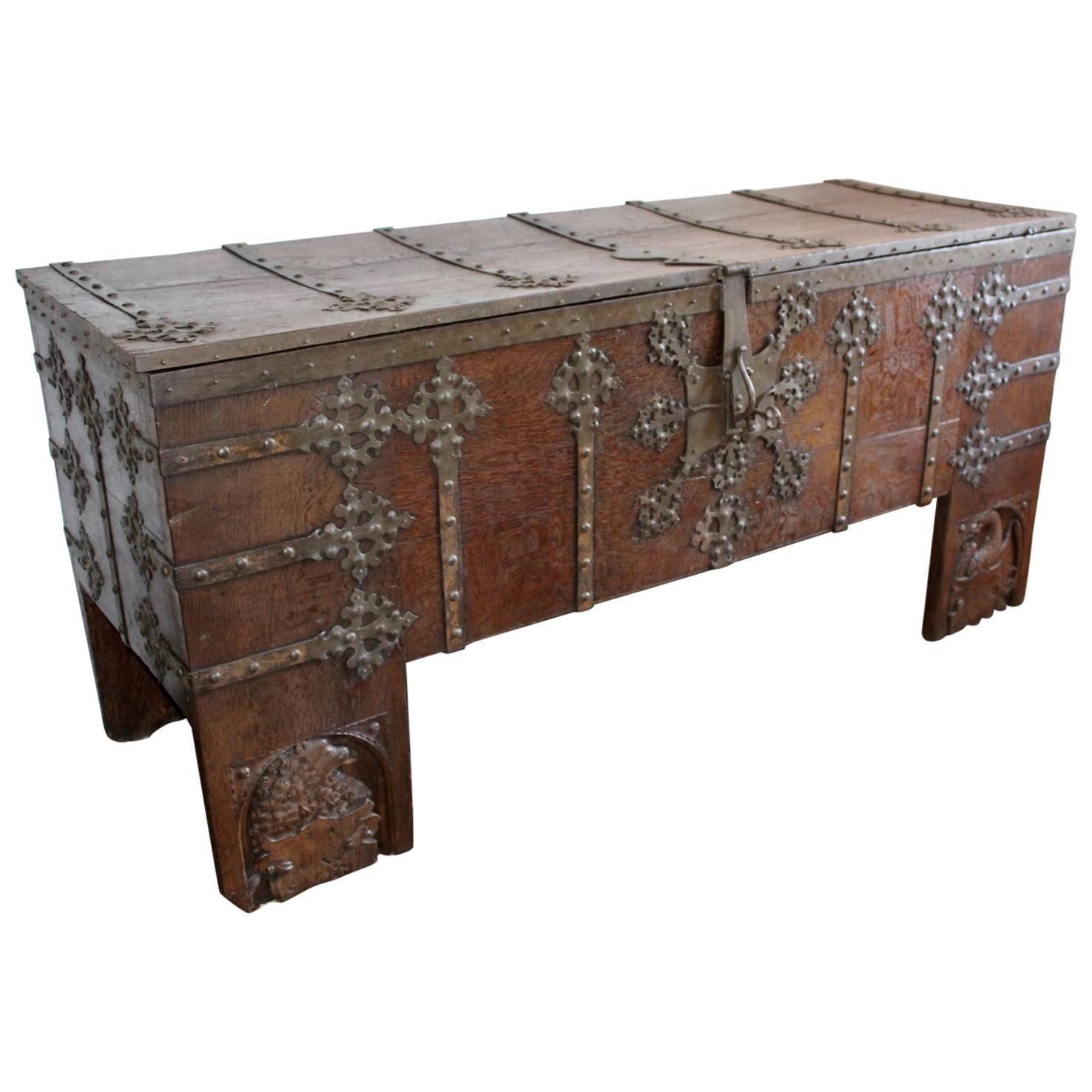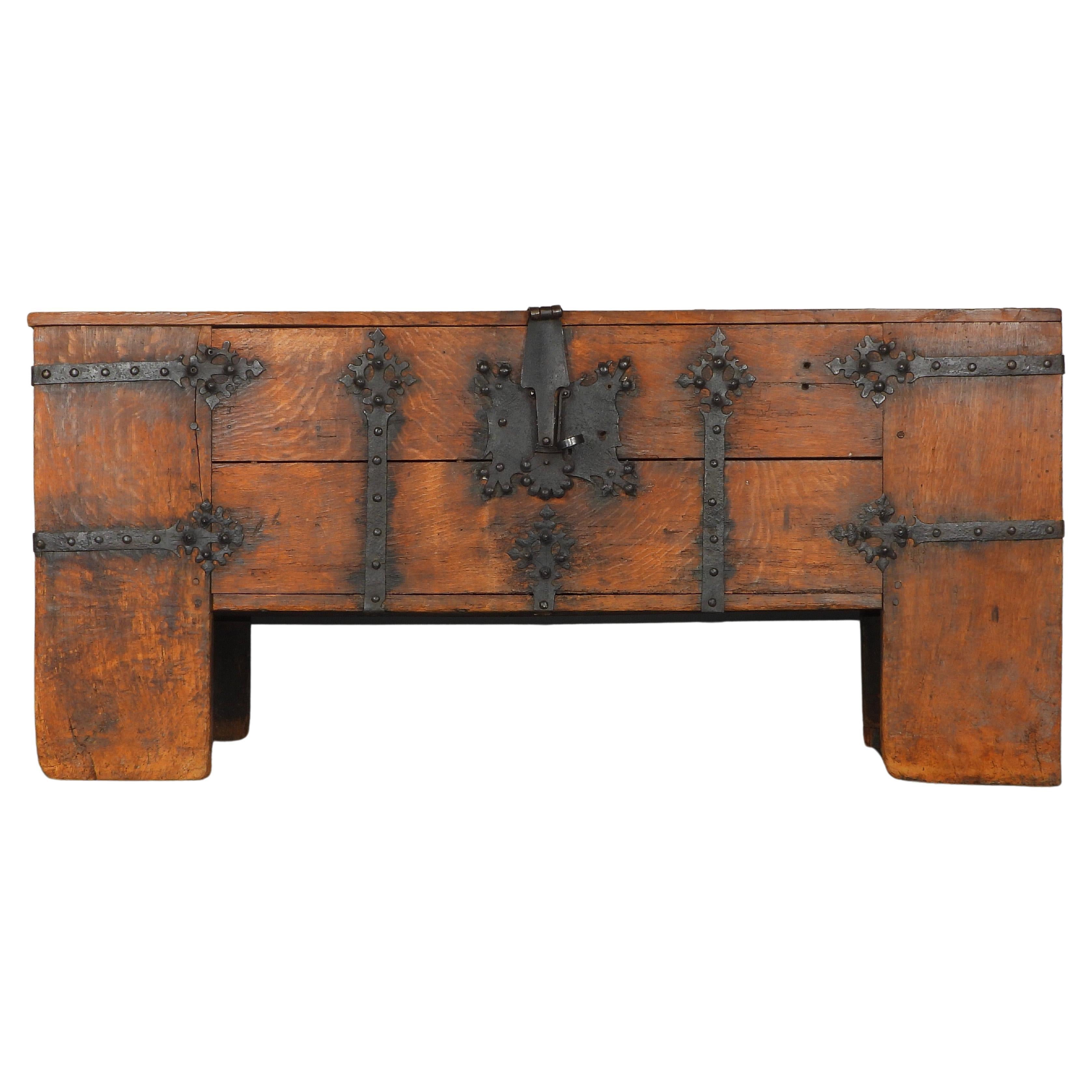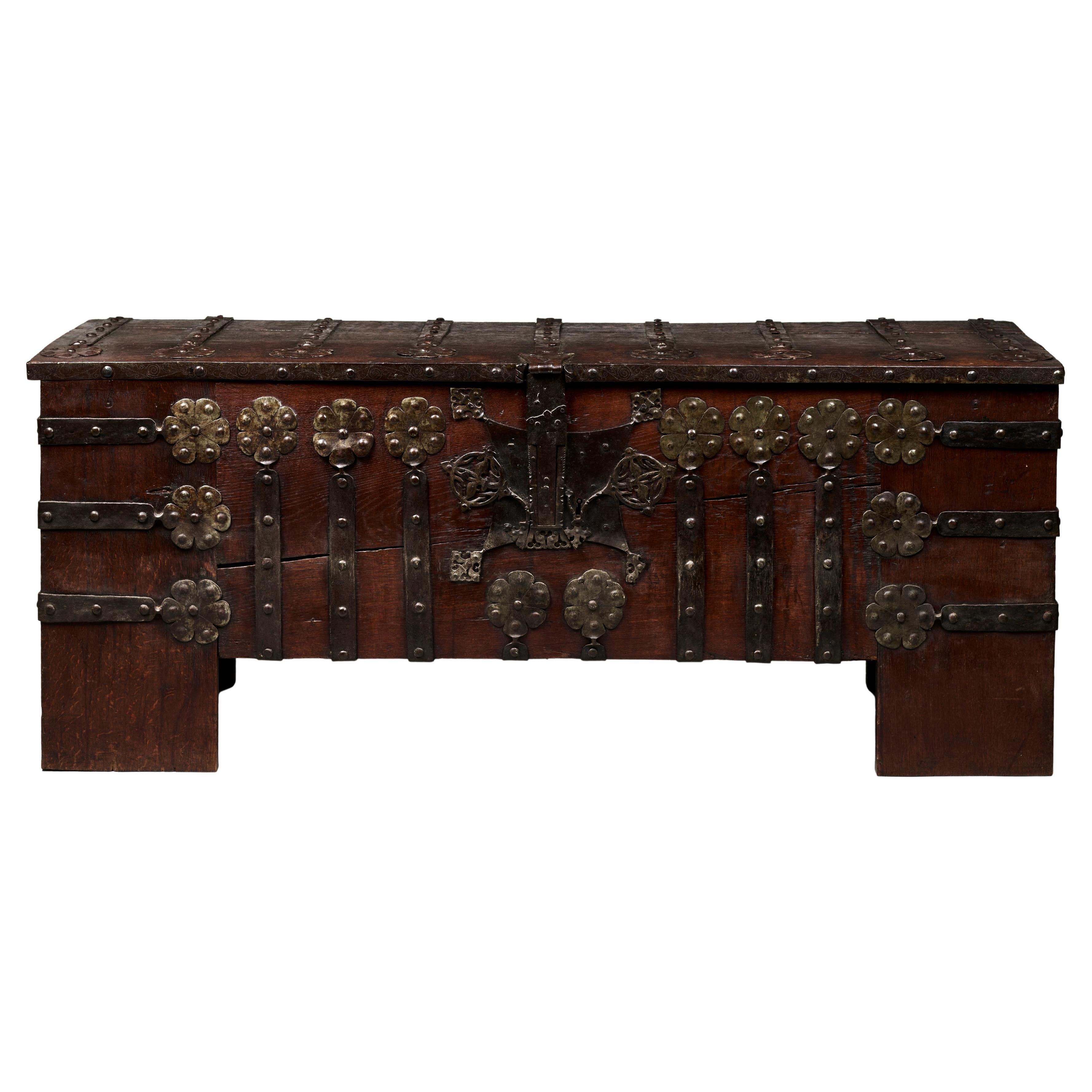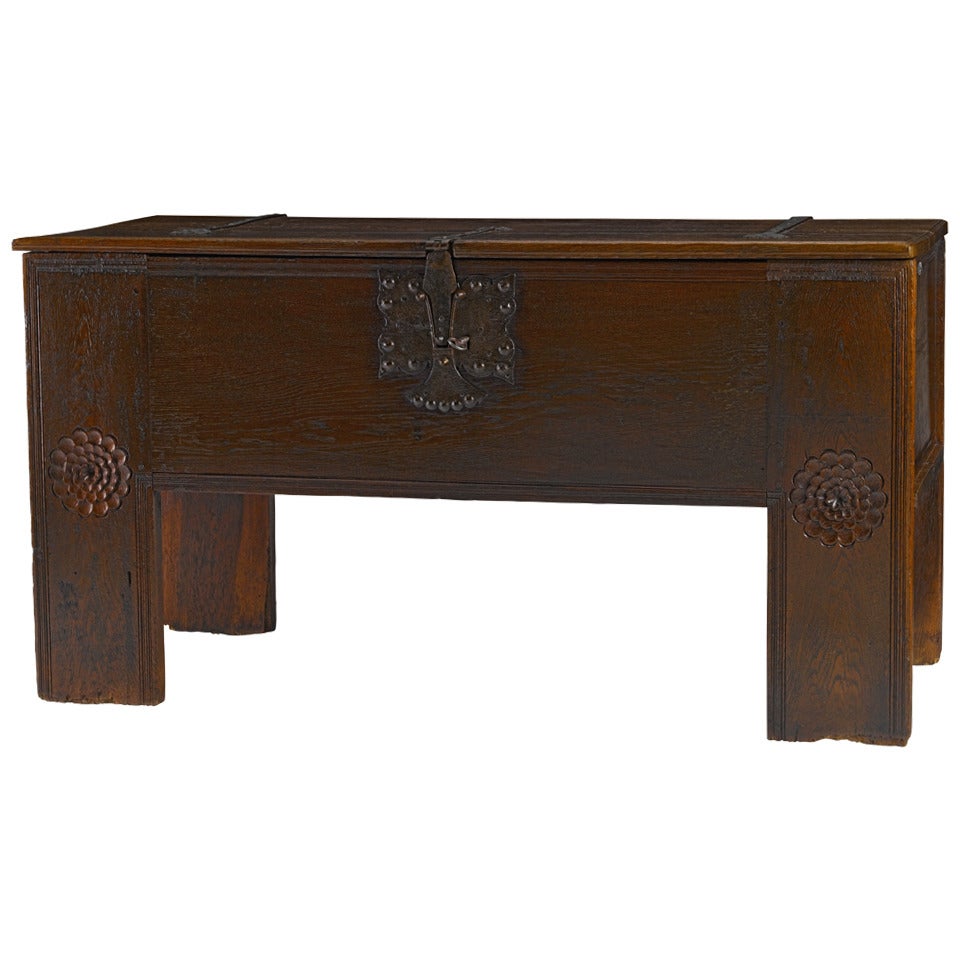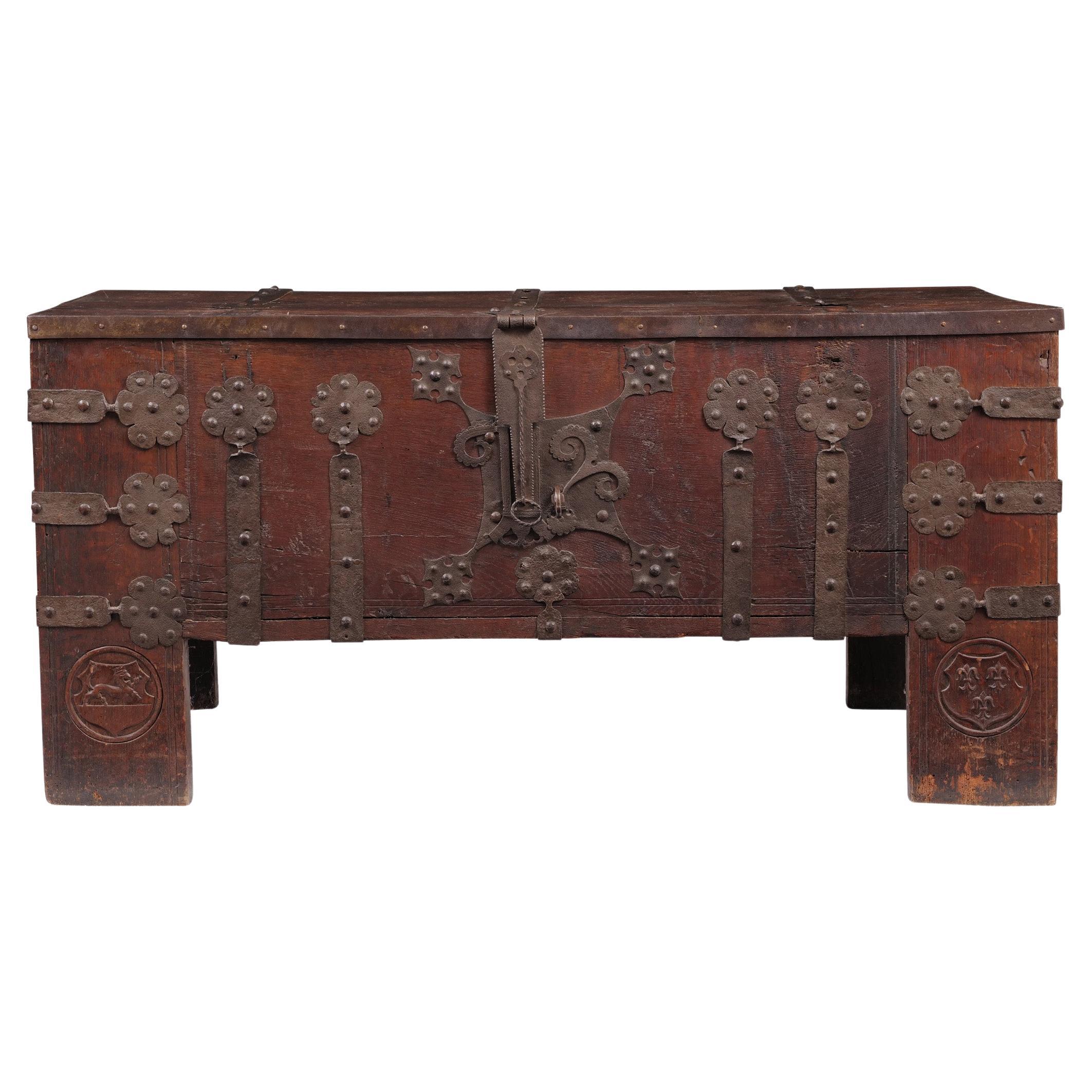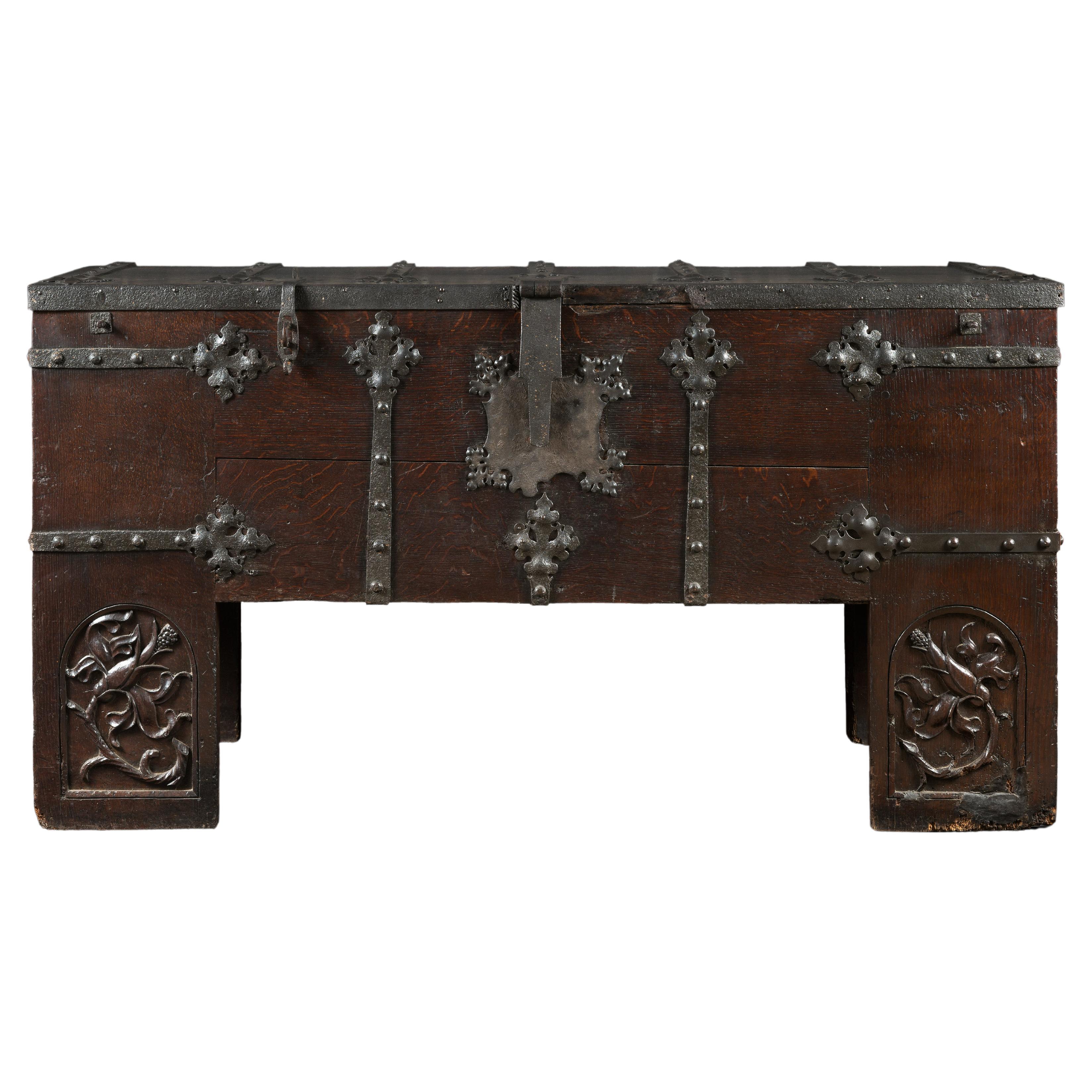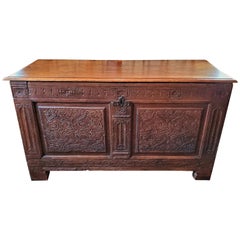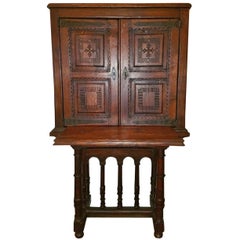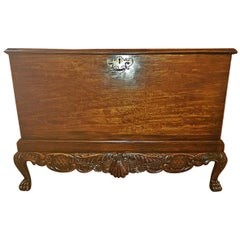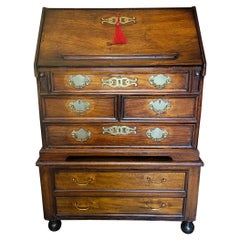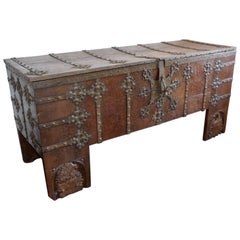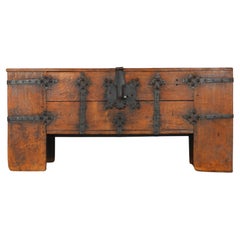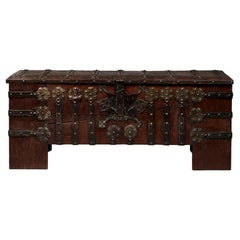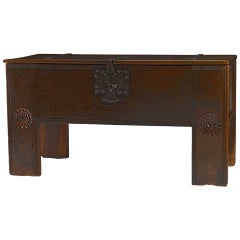Items Similar to Rare (Late Medieval) 16th Century German Wrought Iron Oak Chest or Stollentruhe
Want more images or videos?
Request additional images or videos from the seller
1 of 21
Rare (Late Medieval) 16th Century German Wrought Iron Oak Chest or Stollentruhe
$36,000
£27,079.57
€31,213.73
CA$50,709.99
A$55,640.93
CHF 29,119.88
MX$684,751.44
NOK 366,866.77
SEK 343,625.39
DKK 233,069.48
About the Item
WE HAVE THE PLEASURE TO PRESENT an Exceptionally Rare (Late Medieval) 16th Century German Wrought Iron Oak Chest or Stollentruhe.
This is an Early 16th Century, circa 1500-1550, Stollentruhe or German Gothic Chest, from most likely the Province of Westphalia.
It is made of oak and tiger oak, with exceptional wrought iron bands and adornments, with a STUNNING central lock section with the original key and working lock.
Once opened, it reveals a lidded and hinged candle box and storage space.
What adds to the exceptionality of this piece is it’s ORIGINALITY.
It only has one area, where there is evidence of a historic repair, namely, the top/lid’s hinges. This is not surprising in the least, as with most chests from the more recent 18th or 19th Centuries, will have replacement hinges, due to the weight of the chest top when opened and breakages from being let fall backwards, over time. When one considers that this chest is 500 years old, it is hardly surprising that the hinges required some work, at some time, probably in the 19th Century. In this case, one can see where a new wrought iron bracket has been placed on the back of the chest and attached to the ORIGINAL top bracket and hinge, thereby keeping it as original and true to it’s original construction as possible.
Apart from that repair, this chest is SIMPLY STUNNING in it’s ORIGINALITY and construction. Everything else is original, right down to the handmade iron nails.
What elevates this piece in it’s desirability and collectability, is the fact that it’s raised legs have never been cut down or reduced in size from their original height.
These types of chests were always constructed on raised platform feet or legs, as they would have stood on stone floors and raising the chest meant that the contents were protected from the damp and wet. With most of these very early chests (both British and otherwise) the very bottom of the feet or platforms would rot over time, due to coming into contact with wet, damp floors (think of mopping) this would result in the owners cutting the four legs to the same length, to remove the rotted areas.
It is VERY RARE indeed, to find one of these chests that has not had it’s legs cut down over time.
There are only in the region of 4 of these chests for sale Worldwide:- 2 in Germany and 1 in the UK and OURS.
Whilst, some of the other chests on the market, have more ornate decoration, this one is exceptional because of it’s originality.
THIS CHEST WAS IN EXISTENCE, WHEN MARTIN LUTHER WAS LEADING ‘THE REFORMATION’
IRONICALLY, IN PROVINCES NEIGHBORING WESTPHALIA
Most people refer to these as blanket chests, but on this I am going to slightly disagree, Whilst the candle box is often replicated in subsequent variations on the model of a blanket chest, I simply cannot reconcile the elaborate locking mechanism, as being something that would be necessary to protect simple linens. Also, the height of the piece is not conducive to it being used at the base of a bed for bed linens. Also, the elaborate banding and craftsmanship of the wrought iron, is something that was intended for display and not to be hidden away in a bedroom.
In my opinion, therefore, this is a ‘silver or treasure chest’ for keeping valuables securely under lock and key, like for example, silver candelabras etc – hence, the candle box.
Construction:
The chest is of joined, ‘clamp-front’ construction, reinforced by the nailed, iron mounts. In total it uses ten, oak boards which were riven and planed. The back and front are each formed from a large single plank held to the full height stiles by long, pegged tenons. The sides are also single boards joined into the stiles using long tenons held by dowels, and extend down below the chest bottom, concealing the ends of the bottom boards. The bottom consists of a single board cut into the sides and shallow rebates in the stiles. The front and back boards are dowelled into the bottom boards. The lid which overhangs the sides has a narrow cleat at each end, and consists of one wide plank which has bowed a little as a result of shrinkage.
Ironwork :
The wrought ironwork straps, lock-plate, hasp and lock all appear all appear to be early, and of the same original manufacture and are fixed with convex headed nails. There is mild dark staining of the oak around the iron mounts, possibly because of low tannin content in the oak.
Related to:
No 900:2-1904 V&A Museum, London. Stadtmuseum Dusseldorf. Decorative Arts Museum Berlin. Museen Schleswig-Holstein & Hamburg. A related example featuring elaborately-carved feet and formerly in the Horsham Museum, West Sussex, sold at Christie’s in 2010 for £97,250 and another example, again with carved feet sold at Sothebys in 2006 for £48,000.
Literature:
A similar example is illustrated in H. Lüttgens, Alt- Aachener Wohnkultur; Ein Rundgang durch ein altes Aachener Haus im Wohnstil des 18. Jahrhunderts, Aachen, n.d., ill. 12, and another comparable iron-bound chests illustrated in H. Kreisel, Die Kunst des Deutschen Möbels, Munich, 1974, pls. 45-46.
This type of large oak standing chest is known as a ‘stollentruhe’ (studded chest) and is thought to have been made from at least the early-16th century, based on the style of ironwork and form of the front legs which tend to be carved on earlier models. The German Renaissance was established and Albrecht Dürer and Lucas Cranach the elder were famous throughout Europe. The type has become closely associated with the Westphalia region in central, western Germany (between the Rhine and Weser rivers, located north and south of the Ruhr River).
Comparative literature:
• Baumeier, Stefan, Beschlagene Kisten; Die ältesten Truhen Westfalens, Essen, 2012.
• Falke, Otto von, Deutsche Möbel des Mittelalters und der Renaissance, Stuttgart, 1924.
• Kreisel, Heinrich, Die Kunst des deutschen Möbels, Von den Anfängen bis zum Hochbarock, München, 1968, Band I.
• Stülpnagel, Karl Heinrich von, Die gotischen Truhen der Lüneburger Heideklöster, Cloppenburg, 2000.
• Windisch-Graetz, Franz, Möbel Europas, Band I, Von der Romanik zur Spätgotik, München, 1982.
Provenance: From a Fine Dallas Collection.
Condition: Very good original condition. Some natural wear and minor loss to some of the wrought iron straps. There is a crack on the chest top/lid through age and wood shrinkage, but the crack does not in any way destabilize the top/lid and is cosmetic in nature only. Rear hinges historically repaired (See full posting for details).
Dimensions: 35.5 inches tall, 69.5 inches wide and 24.5 inches deep
- Dimensions:Height: 35.5 in (90.17 cm)Width: 69.5 in (176.53 cm)Depth: 24.5 in (62.23 cm)
- Style:Gothic (Of the Period)
- Materials and Techniques:
- Place of Origin:
- Period:
- Date of Manufacture:1500-1550
- Condition:Repaired: Rear Hinges only. Wear consistent with age and use. Minor losses. Minor structural damages. Minor fading. Very good original condition. See full posting for details.
- Seller Location:Dallas, TX
- Reference Number:1stDibs: LU3978122120762
About the Seller
4.9
Gold Seller
Premium sellers maintaining a 4.3+ rating and 24-hour response times
Established in 2015
1stDibs seller since 2018
393 sales on 1stDibs
- ShippingRetrieving quote...Shipping from: Dallas, TX
- Return Policy
Authenticity Guarantee
In the unlikely event there’s an issue with an item’s authenticity, contact us within 1 year for a full refund. DetailsMoney-Back Guarantee
If your item is not as described, is damaged in transit, or does not arrive, contact us within 7 days for a full refund. Details24-Hour Cancellation
You have a 24-hour grace period in which to reconsider your purchase, with no questions asked.Vetted Professional Sellers
Our world-class sellers must adhere to strict standards for service and quality, maintaining the integrity of our listings.Price-Match Guarantee
If you find that a seller listed the same item for a lower price elsewhere, we’ll match it.Trusted Global Delivery
Our best-in-class carrier network provides specialized shipping options worldwide, including custom delivery.More From This Seller
View All17th Century English Carved Oak Dowry Chest
Located in Dallas, TX
Presenting an absolutely gorgeous and historic 17th century English carved oak dowry chest.
Made of solid oak in England,...
Category
Antique Early 17th Century English Jacobean Blanket Chests
Materials
Oak
$1,575 Sale Price
77% Off
Carved Spanish Oak Writing Cabinet, Estate of Vincente Blasco Ibanez
Located in Dallas, TX
Presenting an absolutely stunning 16th century carved Spanish oak writing desk and cabinet, with amazing provenance and historical and literary significance.
This desk/cabinet was purchased by a wealthy Dallas family from a French antique auction held at the club room in the Stoneleigh court (hotel), Dallas on Wednesday the 2nd April 1930. (Now the meridian hotel). The auction was titled: “works of art and furnishings of the Chateau de Turique (Nancy) and the Conde-Rougemont home (Touraine). The cover of the catalog also has a seal of a coat of arms. The second page gives a brief description of the auction contents and states that " this exhibition will be presented by M. Fernand M. Adda of Paris France". The desk/cabinet was lot no: 565 and was described in the auction catalog as:
"Carved Spanish writing desk and cabinet...... 16th century period....Upper section a cabinet with two doors which are paneled and display a fine carving. The interior is fitted with eight engraved drawers, and a writing tablet is disclosed in the lower portion. Sustained and central arcade of columns. From Fontana Rosa collection. Supported on four turned legs with bulbous feet."
Fontana Rosa is a historic garden situated on the avenue Blasco Ibáñez in Menton, Alpes-Maritimes, on the French Riviera. The Spanish writer Vicente Blasco Ibanez (1869-1928) began to build it from 1922 on, and he set up home here with his second wife, Elena, and died there in 1928. Vicente Blasco Ibanez was a journalist, politician and best-selling Spanish novelist in various genres whose most widespread and lasting fame in the English-speaking world is from Hollywood films adapted from his works. The provenance is impeccable, it belonged to Ibanez and was part of his collection at Fontana Rosa when he died in 1928.
The auction in which it was first sold in Dallas was in 1930, which makes perfect sense from a 'timeline' point of view. Ibanez is a very important literary figure. Having regard to the fact that this is a writing desk means that in all probability, Ibanez would have 'penned' some of his famous works at this very desk and using the surviving slope/shelf.
Fontana Rosa is a historic garden situated on the Avenue Blasco Ibáñez in Menton, Alpes-Maritimes, on the French Riviera.
The Spanish writer Vicente Blasco Ibáñez (1869-1928) began to build it from 1922 on, and he set up home here with his second wife, Elena, and died there in 1928.
This garden with Spanish and Menton pottery is found in avenue Blasco Ibanez, near Garavan station, and was created a Historical Monument in 1990.
It is also called “Le Jardin des Romanciers” (El Jardín de los Novelistas/The Garden of Novelists), and was frequented by celebrities such as Jean Cocteau. It was the place where Blasco Ibáñez wrote Mare Nostrum, a novel filmed later in 1926.
The garden inspired by Andalusian and Arabian-Persian styles contains species such as Ficus macrophylla, Araucaria heterophylla , palm trees, banana trees or scented rosebushes. It is a tribute to Vicente’s favourite writers : Cervantes, Dickens, Shakespeare or Honoré de Balzac, whose busts can be found at the entrance and to whom he dedicated several fountains and rotundas.
Its main buildings are a small elevated villa with polychromatic pottery which houses a library and a personal movie projector...
Category
Antique 16th Century Spanish Renaissance Cabinets
Materials
Oak
$10,000 Sale Price
20% Off
18C Irish George II Mahogany Silver Chest on Exceptional Carved Stand
Located in Dallas, TX
PRESENTING AN ‘ABOLUTELY STUNNING’ PIECE OF IRISH FURNITURE HISTORY, namely, an 18C Irish George II Mahogany Silver Chest on the most amazing and EXCEPTIONAL Carved Stand.
Made circa 1745, by an obviously ‘top quality’ Irish Georgian furniture...
Category
Antique Mid-18th Century Irish George II Blanket Chests
Materials
Mahogany
$32,000 Sale Price
28% Off
18th Century George II Miniature Campaign Bureau Chest on Later Chest Stand
Located in Dallas, TX
PRESENTING A GORGEOUS and beautifully proportioned Mid-18th Century George II Miniature Campaign Bureau Chest on later Chest/Stand.
Mid-18th century, made in Britain, circa 1760-1770.
The bureau chest sits on a later stand/chest, that we estimate is late 19th century, circa 1860-1880. It is also British.
We believe that the primary wood in this piece is either Elm or Sycamore with mahogany elements.
Classic Campaign style miniature Bureau Chest, with its ORIGINAL George II brass hardware, including handles on the sides for easy carriage, which is what proves to us, that this chest was made for campaign purposes.
The brasses are GORGEOUS and are classically George II in style, design and construction.
The quality, thickness and patina to the brasses, is what ‘initially’ tells us, that this is a ‘period’ piece and not a reproduction.
Likewise, the dovetailing detail to the drawers, tells us that this was a hand crafted piece and certainly NOT machine made.
The secondary woods appear to be a combination of oak and pine, exactly as one would expect.
The central keyhole escutcheons are FANTASTIC and are in the form of a pair of opposing ‘lyres’.
We have never seen anything like them!
Beautiful natural patina!
The ‘brasses’ look like they have been polished a ‘little too often and vigorously’, over the piece’s 250+ years history … BUT … the bonus of this cleaning is the creation of a rather appealing, '2 Tone effect’, on the patina of the wood around the brasses.
The Bureau has a flat gallery...
Category
Antique 18th Century English George II Secretaires
Materials
Brass
18th Century Irish Georgian Cork Sideboard
Located in Dallas, TX
Presenting a gorgeous and very rare 18th century Irish Georgian Cork Sideboard of lovely neat proportions.
Made in Ireland during the George III Era, circa 1790 and most likely made in the Southern City of Cork.
A STUNNING Irish provincial piece from the Georgian Era!
Made of solid mahogany, probably imported from Cuba and the secondary woods are oak (as one would expect). Beautiful dovetailing on the inside of the drawers.
The ‘hints’ that this is in fact an ‘Irish’ piece are numerous. The ‘scallop shell’ on the center of the back gallery is unmistakably an Irish Georgian signature. The scalloped fans beneath either side of the central drawer are likewise an Irish signal. The shape, design and style is entirely consistent with similar pieces made in Cork at the end of the 18th Century.
It has it’s original brasses which is fantastic. Lions Head Ring drawer pulls and stunning urn keyhole covers/escutheons.
It has a solid gallery back splat (with central Scallop) and on both sides this ends in curved and carved scroll ends. Beneath the back splat their is a grooved plank section for holding plates etc upright.
The server/counter top area is edged and banded with a carved rope style edging.
The mid section consists of 3 drawers and 2 doors.
The piece sits on 6 legs 4 to the front and 2 to the rear. The front legs are pillars starting at the top with an acanthus style scroll … extending down to another scroll carving directly above the reeded and fluted legs. The 2 rear legs do not have the same fluting detail.
The 2 side doors open to reveal a simple one shelf storage area. One probably held a lead lined cellarette at one time.
The piece is in excellent condition for it’s age and use. There are some minor aging cracks on the counter top on the left hand side. A small loss of molding to the right lower door. No original keys but we are getting replacements made.
Bought in Surrey, England in 1999 by a Private Texas Collector and shipped to Texas. We have the original ‘sales invoice’ and the dealer sold it as a “Regency Mahogany Sideboard circa 1820’and told her that it was an English piece, for the sum of 3,400 GBP. Not only did the dealer not recognize the obvious ‘Irish’ signs...
Category
Antique Late 18th Century Irish George III Buffets
Materials
Mahogany, Oak
19c Anglo Indian Highly Carved Teak and Sandalwood Sarcophagus Sewing Box
Located in Dallas, TX
PRESENTING A VERY NICE 19C Anglo Indian Highly Carved Teak and Sandalwood Sarcophagus Sewing Box.
Made in Bombay, India circa 1890-1900.
The box case/body is made of sandalwood wit...
Category
Antique Late 19th Century Indian Anglo-Indian Decorative Boxes
Materials
Bone, Sandalwood, Teak
You May Also Like
Rare Late Medieval 16th Century German Wrought Iron Oak Chest or Stollentruhe
Located in Worpswede / Bremen, DE
A very impressive Westphalian Gothic chest or ‚Stollentruhe’, Westphalia, Germany, circa 1500-1550. Wrought iron mounted oak, partially carved. The monumental rectangular standing chest with full-height stiles, extensively mounted with wrought ironwork straps terminating in quatrefoil finials which ’wrap’ around the chest edges. These are fixed with convex head nails. The ironwork with some remains of an originally red painted surface. In addition, running along the edges of the lid at the front and sides is a plain iron band, close-nailed. The feet of the two front legs are finely carved on the front face, in low relief with a rectangular arched ’panel’ depicting on the left a lion, on the right a dragon holding each a coat of arms.
Regarding the age of circa 500 years, this coffer is in exceptionally good condition, with only smaller restorations.
Comparative literature
• Baumeier, Stefan, Beschlagene Kisten; Die ältesten Truhen Westfalens, Essen, 2012.
• Falke, Otto von, Deutsche Möbel...
Category
Antique 16th Century German Medieval Blanket Chests
Materials
Iron
Rare Late Medieval 16th Century German Wrought Iron Oak Chest
Located in grand Lancy, CH
A very impressive Westphalian Gothic chest or ‚Stollentruhe’, Westphalia, Germany, circa 1500-1550. Wrought iron mounted oak, partially carved. The monumental rectangular standing ch...
Category
Antique 16th Century German Commodes and Chests of Drawers
Materials
Iron
$26,160 Sale Price
20% Off
Rare Gothic German Oak and Iron Chest Known as "Stollentruhe" 16th century
Located in Worpswede / Bremen, DE
The large rectangular standing chest on stile feet, extensively mounted with wrought ironwork straps with stylised sixfoil motif. These are fixed with convex head nails: running vert...
Category
Antique 16th Century German Gothic Blanket Chests
Materials
Iron
17th Century German Iron-Mounted Oak Chest / Trunk "Stollentruhe"
Located in Worpswede / Bremen, DE
A 17th century German oak chest ("Stollentruhe") in the medieval/ Gothic tradition. The rectangular hinged top with three iron straps, enclosing a plain interior with one hinged smal...
Category
Antique 17th Century German Baroque Commodes and Chests of Drawers
Materials
Oak
Gothic front gallery chest, Westphalia around 1500 - 1550, oak
Located in Münster, DE
Gothic front gallery chest, Westphalia around 1500 - 1550, wrought iron bands, boxy oak body, partially carved. Monumental star-shaped key plate with original key, feet on the front ...
Category
Antique 16th Century German Gothic Blanket Chests
Materials
Oak
$15,839 Sale Price
20% Off
Rare Gothic German Oak and Iron Chest Known as "Stollentruhe"
Located in Saint-Ouen, FR
This large chest stands on high legs prolonging the lateral jambs. Presenting a sober and severe appearance the chest still belongs to the Medieval tradition. The piece is made from very high quality Hungarian wood.
The jambs are joined to the facade and the lateral sides thanks to pegged mortise and tenon securing a great stability and squareness between each parts. The upper lid is made of two joined parts and so is the facade.
The ironwork is present all over the surface of the chest and brings both an additional stability to the construction as well as a rich decor. The lid is secured with hinges. Hinges also run all over the chest in horizontal and vertical lines, ending in a floral motif. The hasp lock is also very ornamental.
Those chests always present important proportions especially when they are made early in the period. This model was very popular in Germany and stayed in vogue until the 16th century. However the feet Gothic decor...
Category
Antique 15th Century and Earlier German Gothic Blanket Chests
Materials
Wrought Iron
